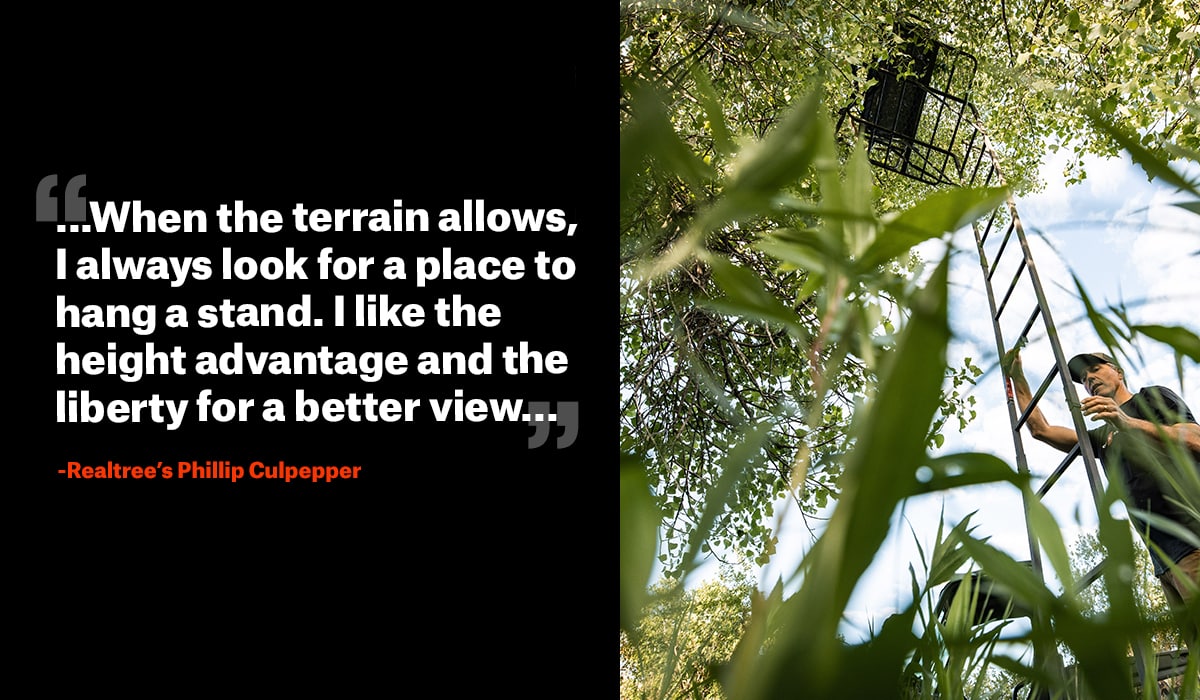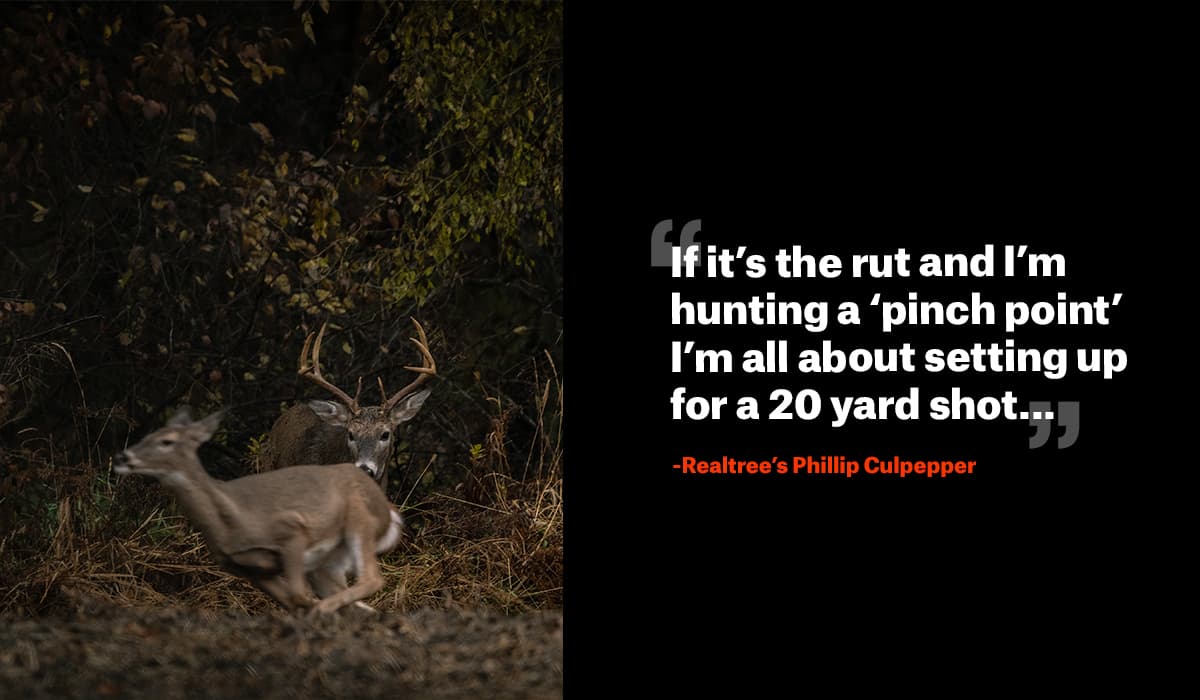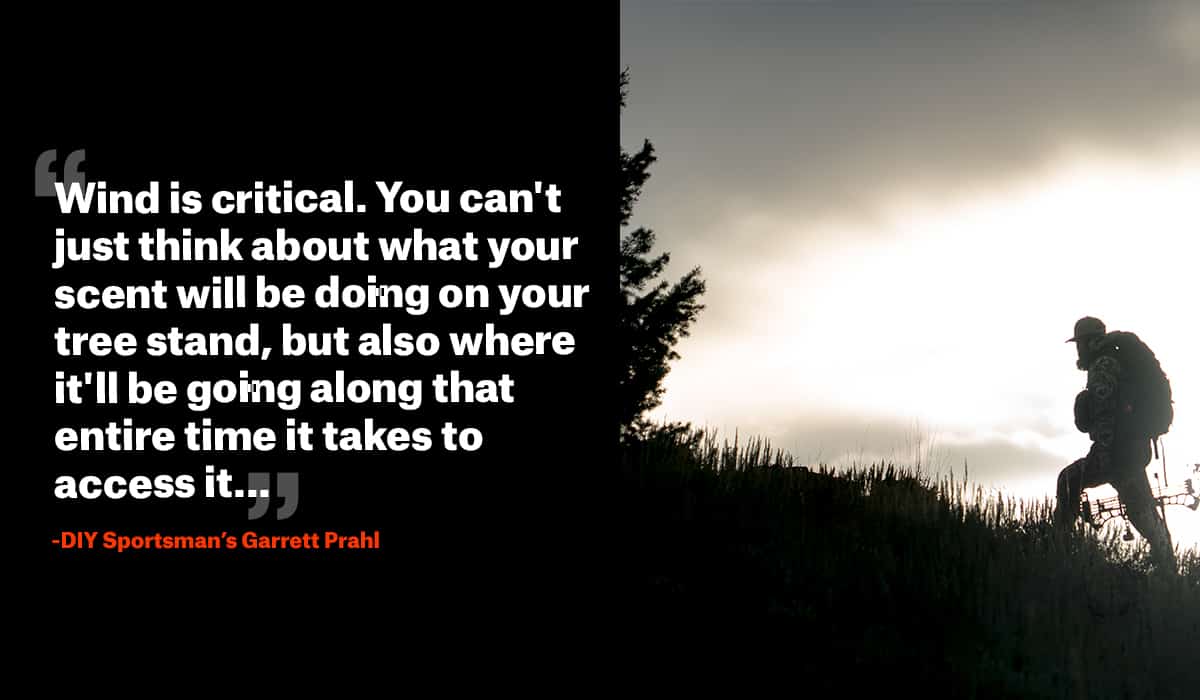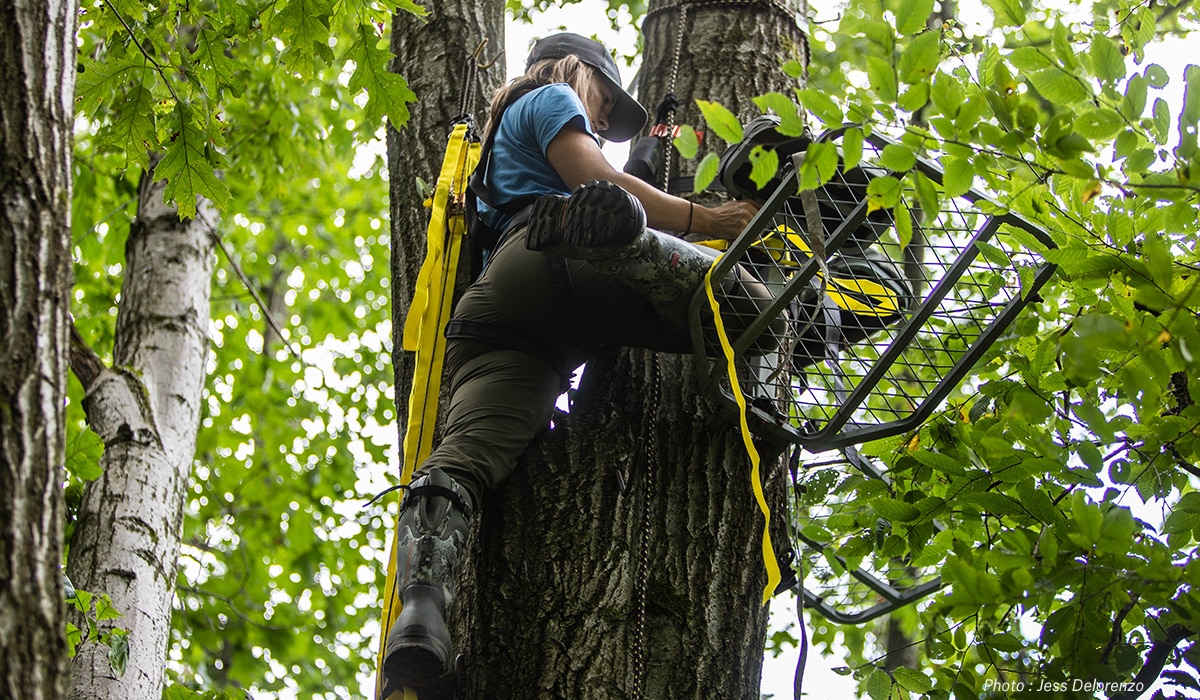Tree stands come in many shapes and sizes, but they all serve a similar purpose–to give you an elevated, hidden position from which to shoot. No matter what state you’re hunting whitetails in, using a well-placed tree stand can give you the edge you need, but a poorly hung tree stand can ruin a season. Here are the top tactics for setting up a tree stand you can use to seek success.
Types of Tree Stands
Ladder stands, tripod stands, climbing stands and hang-on stands all offer different pros and cons depending on your terrain, cover and hunting situations, but generally they all aim to get hunters off the ground for better viewpoints and better shots. As these top tactics can be applied to a variety of tree stands, each may need to be adjusted to your specific stand type.

“I think both ground blinds and tree stands have their advantages and disadvantages depending on the situation. Personally, I absolutely love being 25 feet up a tree. When the terrain allows, I always look for a place to hang a stand. I like the height advantage and the liberty for a better view.” -Realtree’s Phillip Culpepper
Here’s a list of common tree stand variants you might be setting up:
Climbing Tree Stand
A very minimal stand that doesn’t require excessive climbing gear. The climbing tree stand typically features two platforms, with one attaching to the hunter’s feet. Just as an inchworm would climb along a leaf, one platform is secured to the tree while the other moves up and locks in place. Then the other platform moves up, and so on.
Ladder Stand
As its name implies, a ladder stand is simply a ladder attached to a platform. A ladder stand is generally set up for an entire season, and they are not adjustable for different heights. They are easy to climb and might offer more platform space from which to shoot.
Tree Saddle
Gaining in popularity and frequently see on The Hunting Public, tree saddles cradle your backside while tethering you to a tree. Your feet rest on a small platform and you can sit comfortably, bracing your knees against a tree, or stand while leaning back to make a shot.
Tripod Deer Stand
Also known as the tower stand, these tree stands are freestanding platforms supported by three or four legs. These are useful in open country when there are no, or limited, trees for other types of stands.
Hang-On Tree Stand
Hang-on tree stands are versatile and very popular, allowing you to hang your tree stand from virtually any tree exactly the way you want it. With a hang-on stand, you’ll need to use tree steps or a climbing stick to access the stand. Hang-on tree stands are great for trees that aren’t straight or have lots of limbs, which climbing tree stands wouldn’t be able to climb.

Tree Stand Placement
Not every tree is a perfect fit for a tree stand. That’s why learning the art of tree stand placement is key for better hunting success. Factors like orientation, height and potential obstructions should be top of mind when placing your stand.
“When prepping a stand location, visualize the most likely deer approach and what they’ll be able to see. Set the platform in a way that would require a minimal amount of movement to grab your bow, draw, and shoot.” -DIY Sportsman’s Garrett Prahl
Finding the right tree is the first step in placing a good tree stand. Trees around 18 inches in diameter or larger seem to work best. They’re sturdy enough to support your body weight and wide enough to hide your shoulders. Thinner trees will expose your outline.
Keep the sun on your back. The lens of human eyes filters out UV light, but deer lack a UV filter. If you know the direction from which a deer might approach try to hang your tree stand so you’re between it and the sun.
Cover also plays a factor when you’re looking for the perfect tree because not every tree is created equal. Stand where you expect the deer to offer a shot and look up at the tree. The sun should be shining in your face depending on the time of day. Now imagine a person in that tree. Would it create a big silhouette?
This is a deer’s home, and you are just a visitor. If a picture on the wall in your house was moved to a different spot when you came home, would you be a little nervous? Same thing goes for deer. Find a tree that has enough leaves and branches to break up your outline, and especially consider cover behind the stand. Also remember most trees other than pines lose their leaves. A stand in September might be fully covered with leaves, but when you come in November it could be wide open.
While the winds might change, your hunting tree stand does not. Expert hunters will rely on more than one tree stand in a season and choose the one with the best wind direction that day. This is what hunters refer to as “hang and hunt.” This method allows you to find the best spot for that day of hunting, hang a stand, and hunt from that stand – hence hang and hunt. It takes practice to be efficient and quiet while hunting this way. Can you hang and access your tree stand five times in a row at home without making noise? If not, keep practicing.

“If it’s the rut and I’m hunting a ‘pinch point’ I’m all about setting up for a 20 yard shot. If it’s early season or late season, and I’m sitting on a heavy food source, I like to sit within shooting distance of where the deer are going (30-40 yards).” -Realtree’s Phillip Culpepper
Tree stand height is extremely important to understand for hunting whitetails. With climbing deer stands, especially, where you can climb to different heights, you’ll want a solid strategy going into each area. Here are several top tactics for hanging tree stands at the right height:
- Place your stand as high as possible when you can. Unless you’re after a particular shot on a whitetail you’ve been monitoring, getting above a deer’s normal line of site (higher than 15-20 feet) will improve your chances of success.
- Find the right height that gives you multiple shooting lanes. Remember, if allowed, you can create or improve a shooting lane by trimming foliage and branches.
- Measure the distance of your expected shot as it relates to the height of your tree stand. It’s ideal to keep your expected bowhunting shot between 15-20 yards.
“Typically, I like to be at least 20 feet off the ground. I would say 23-25 feet is the perfect height. I am scared to death of heights so I rarely ever go above 25 feet. If the terrain is steep I’ll go higher to avoid being ‘eye level’ with deer coming off the ridge, but in a perfect situation around 20 feet is the perfect height. The higher you go, the smaller the kill zone becomes.” -Realtree’s Phillip Culpepper
Getting to Your Deer Stand
Don’t break your hunt before it’s even started by making these common mistakes getting to your deer stand. You’ve put the work into hanging the best tree stand possible; now it’s time to get to it unnoticed.

“Wind is critical. You can’t just think about what your scent will be doing on your tree stand, but also where it’ll be going along that entire time it takes to access it. When getting close, slow down and use natural noise like wind gusts as cover to silently make the final approach.” -DIY Sportsman’s Garrett Prahl
Guide for Getting to Your Deer Stand:
- Be aware of the wind direction at every point between your hunting rig and your stand. If it’s not favorable, you might need to choose another spot.
- Access your stand from the lowest ground possible. Never walk a ridge line to your stand just because it’s a straight shot. Choose cover over quickness.
- Do not walk along game trails or across fields and food plots to get to your tree stand. You’ll leave your scent anywhere you walk.
- Slow down. Deer eyes are designed to catch movement. If you’re careful with the wind and your scent control you’ll have all the time you need to approach your deer stand without busting a savvy whitetail.

Using onX for Setting up Tree Stands
The onX Hunt App is set up to help you plan and hang your tree stands. Use colored waypoints to mark your preferred hunting stands for different wind directions, or based on morning or evening hunts.
Marking photo waypoints from your deer stand locations is helpful for visualizing the shots you have from that stand. You can reference those waypoints when you’re practicing pre-season bow shooting the following year.

One final, but very important point: always wear your harness. Stay tethered to the tree at all times by using a full-body harness attached to a lineman’s rope that anchors above your tree stand.
“Regardless if you’re 10 feet off the ground or 30 feet, ALWAYS USE A SAFETY HARNESS!!!” -Realtree’s Phillip Culpepper